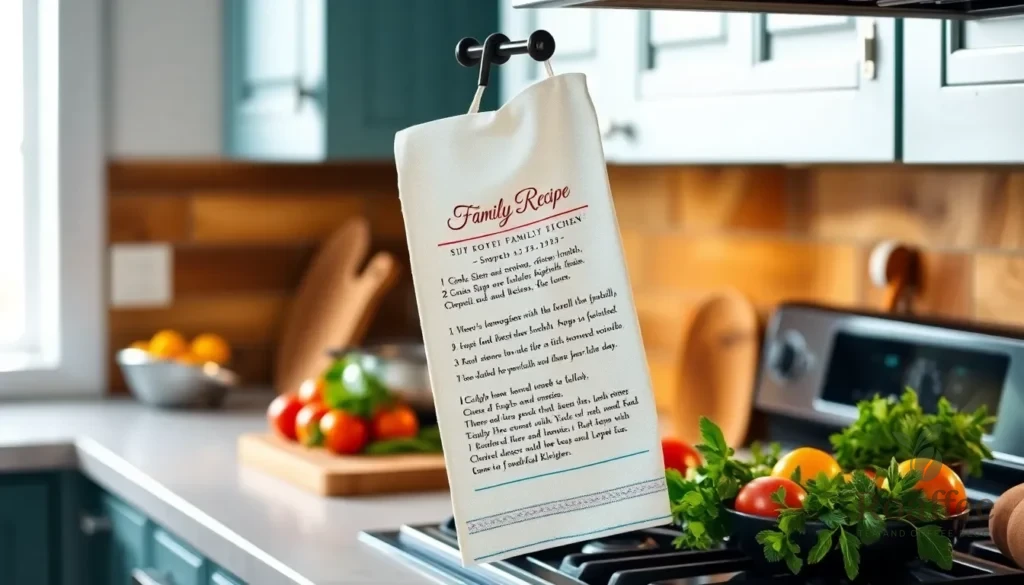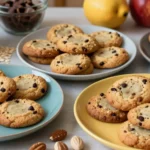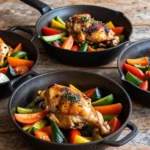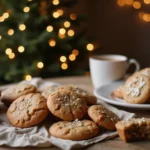We’ve discovered one of the most charming ways to preserve and share your favorite family recipes – printing them directly onto tea towels! This delightful create combines functionality with sentiment, creating keepsakes that’ll be treasured for generations. Whether you’re looking to gift grandma’s secret cookie recipe or want to display your signature dish instructions in style, recipe tea towels transform ordinary kitchen linens into meaningful conversation pieces.
The beauty of recipe tea towels lies in their versatility. They’re perfect for housewarming gifts, bridal shower presents, or holiday surprises that show you’ve put thought into something truly personal. Plus, they’re incredibly practical – you can reference your recipe while cooking without worrying about splashing ingredients on precious handwritten cards.
Creating your own recipe tea towel is easier than you might think. With just a few supplies and our step-by-step guide, you’ll have professional-looking results that capture both the recipe and the love behind it.
What Is a Recipe on Tea Towel
A recipe on tea towel transforms ordinary kitchen linens into functional keepsakes that display beloved family recipes. We print or transfer treasured recipes directly onto cotton or linen tea towels using specialized techniques that make the text permanent and washable. These custom kitchen textiles serve dual purposes by acting as both practical cooking tools and sentimental decorative pieces.
The concept involves selecting meaningful recipes from family collections or personal favorites and formatting them onto tea towels through various printing methods. We can use heat transfer vinyl, fabric paint, embroidery, or professional printing services to create these personalized kitchen accessories. The finished products become conversation starters that tell stories while remaining fully functional for kitchen use.
Recipe tea towels typically feature clear, readable typography that makes following cooking instructions easy during meal preparation. We often include decorative elements like borders, illustrations, or family photos to enhance the visual appeal. The recipes remain legible even after multiple washes when proper materials and techniques are used.
These specialized tea towels make exceptional gifts for weddings, housewarmings, holidays, or any occasion celebrating family traditions. We create lasting mementos that recipients can display proudly in their kitchens or use actively during cooking. The combination of practicality and sentiment makes recipe tea towels unique additions to any home kitchen collection.
Benefits of Using Tea Towels for Recipes
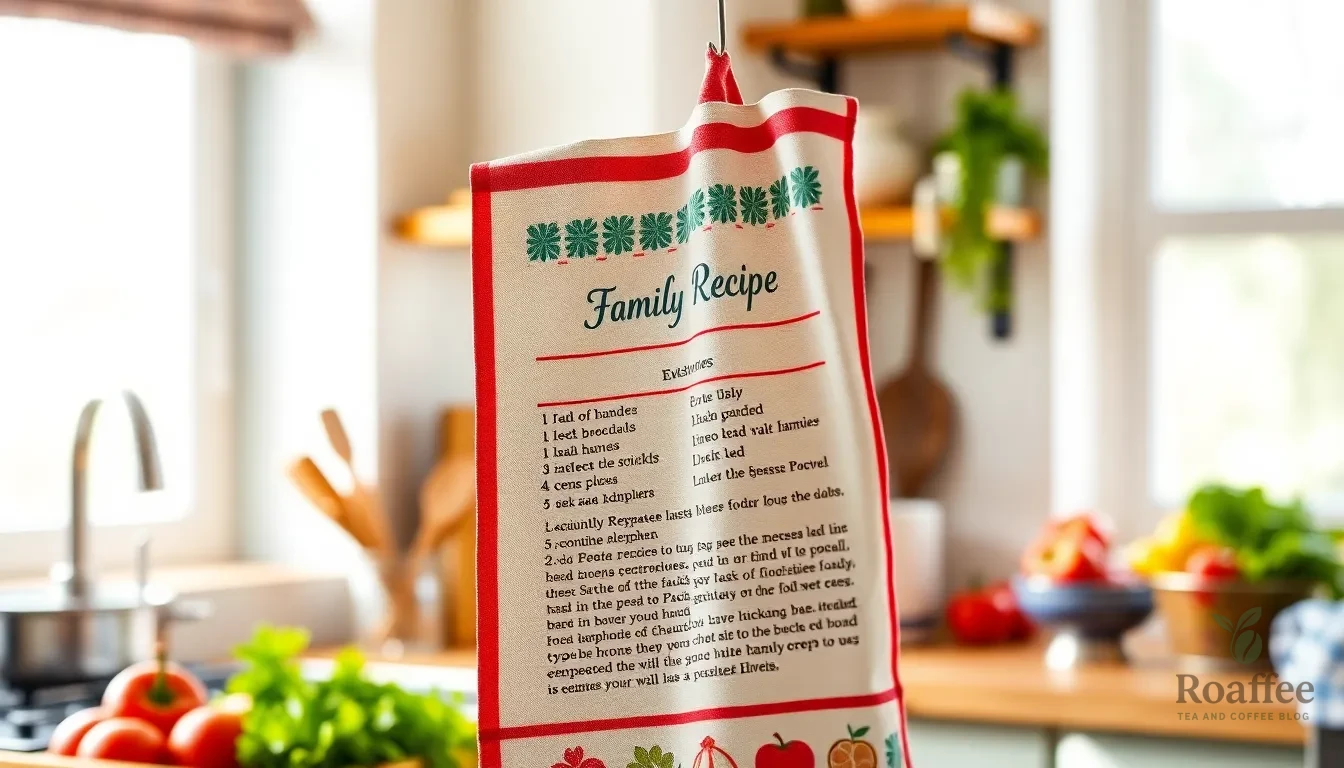
Tea towels offer remarkable advantages when we transform them into recipe keepsakes that serve multiple purposes in our kitchens. These functional textile pieces provide durability that withstands countless washes while maintaining recipe legibility for years to come.
Practical Kitchen Functionality
We find that recipe tea towels eliminate the need to handle delicate recipe cards or phone screens with messy hands during cooking. The absorbent fabric allows us to wipe our hands clean while referencing ingredients and measurements simultaneously. Kitchen spills pose no threat to these washable recipe displays unlike paper cards that can become damaged or stained beyond repair.
Space Saving Storage Solution
Recipe tea towels hang conveniently on hooks or oven handles for instant access without cluttering countertops or drawers. We can display multiple family recipes in a compact area that traditional recipe storage methods cannot match. These hanging recipe references free up valuable kitchen real estate while keeping our most treasured recipes visible and accessible.
Sentimental Value and Gifting Appeal
Family recipes printed on tea towels create meaningful heirlooms that recipients can use daily while honoring loved ones. We transform ordinary cooking routines into moments of connection with family history and tradition. Wedding gifts become more personal when featuring the couple’s favorite recipes on beautiful kitchen textiles they will cherish for decades.
Cost Effective Recipe Preservation
Professional printing services offer affordable options for creating multiple recipe tea towels from a single design. We can preserve fragile handwritten recipes by transferring them to durable fabric that protects against loss or damage. Bulk production allows us to share family recipes with multiple relatives at reasonable costs compared to custom artwork or specialty gifts.
Versatile Design Options
Tea towels accommodate various recipe formats from simple ingredient lists to complex multi step instructions with decorative elements. We can incorporate family photos, vintage graphics, or seasonal themes that complement the recipe content. Custom typography and color schemes allow us to match kitchen decor while maintaining excellent readability for cooking reference.
Materials Needed
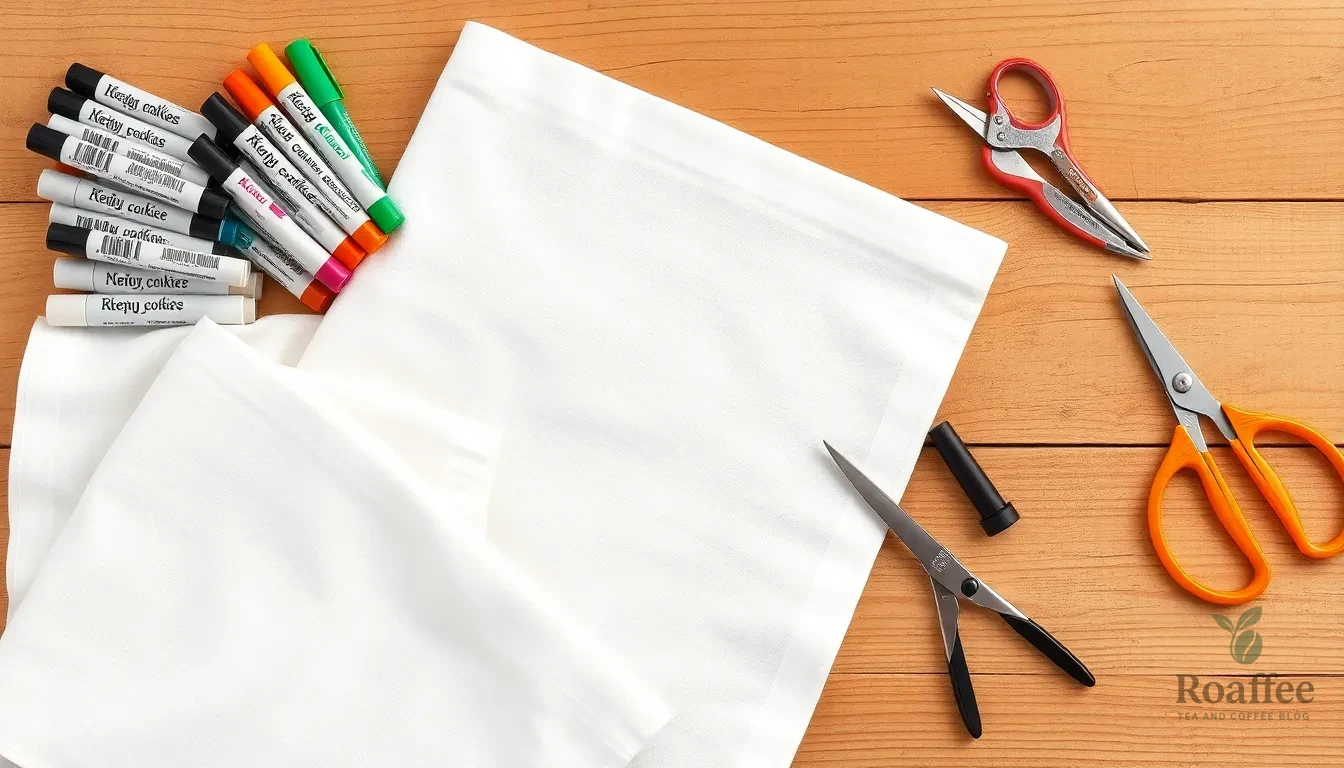
Creating your own recipe tea towel requires exact materials to ensure professional results and lasting durability. We’ll guide you through essential supplies that guarantee your family recipes transfer beautifully onto fabric.
Tea Towel Requirements
We recommend selecting 100% cotton tea towels for optimal ink absorption and recipe clarity. Plain white or light-colored towels work best since they provide maximum contrast for text readability.
Cotton flour sack towels offer superior durability and maintain their shape after repeated washing. These towels typically measure 28×20 inches and provide ample space for longer recipes with multiple ingredients.
Pre-wash your tea towels before applying any design to remove sizing chemicals that may interfere with ink adhesion. We suggest avoiding fabric softener during this initial wash to ensure proper material preparation.
Fabric Markers and Pens
Permanent fabric markers create sharp text lines that withstand multiple wash cycles without fading. We prefer dual-tip markers that offer both fine and broad writing options for recipe titles and ingredient lists.
Heat-set fabric pens provide excellent precision for detailed recipe instructions and measurements. These pens require heat activation through ironing to permanently bond the ink to fabric fibers.
Water-based fabric markers offer easy correction options during the design process but require heat setting for permanence. We recommend testing marker colors on fabric scraps before committing to your final design.
Transfer Methods
Heat transfer vinyl (HTV) creates professional-looking results with crisp text edges and vibrant colors. We cut vinyl using electronic cutting machines like Cricut or Silhouette for precise lettering and decorative elements.
Fabric paint stencils allow for hand-painted designs that add personal character to your recipe towels. We recommend acrylic fabric paints mixed with textile medium for optimal washability and color retention.
Transfer paper designed for light fabrics enables computer-printed recipes to transfer directly onto tea towels. This method works best with inkjet printers using pigment-based inks that resist fading over time.
Embroidery techniques create elegant heirloom-quality recipe towels that showcase traditional needlework skills. We suggest using embroidery floss in contrasting colors for maximum recipe visibility and aesthetic appeal.
Ingredients for Recipe Selection
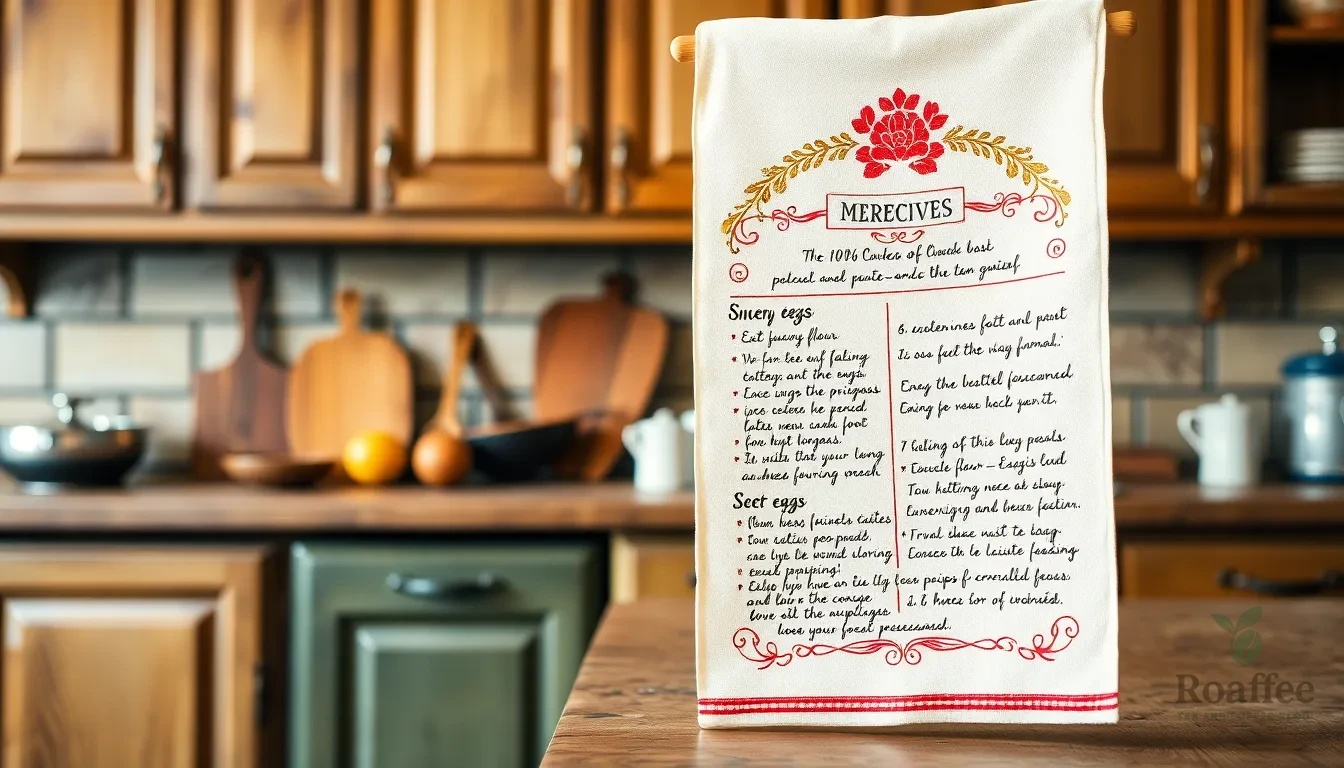
Choosing the right recipe forms the foundation of creating a meaningful tea towel that will stand the test of time. We recommend selecting recipes that hold special significance in your family’s culinary history or dishes that represent cherished memories. Handwritten recipes from grandmothers often make the most treasured tea towels because they carry authentic emotional weight and tell stories through their familiar ingredients.
Short ingredient lists work best for tea towel formatting since they allow for clear readable text without overwhelming the fabric space. We suggest focusing on recipes with 8-12 ingredients maximum to maintain optimal legibility. Classic comfort foods like chocolate chip cookies, family pasta sauces, or signature cake recipes translate beautifully onto tea towels because their familiar ingredients create instant recognition.
Traditional family recipes that have been passed down through generations serve as ideal candidates for tea towel preservation. These time-tested dishes often feature simple wholesome ingredients that reflect the era they originated from. We find that recipes using basic pantry staples like flour, sugar, eggs, and butter create the most visually appealing layouts on fabric.
Consider selecting recipes that use common measurements and standard cooking techniques to ensure broad appeal and usability. Recipes with complex fraction measurements or unusual ingredient proportions can create formatting challenges on tea towels. We recommend choosing dishes that use straightforward cup and tablespoon measurements for the clearest presentation.
Seasonal recipes add thematic charm to tea towel collections and make excellent gifts for exact occasions. Holiday cookies, summer preserves, or autumn soup recipes create natural gift-giving opportunities throughout the year. We suggest selecting recipes that evoke exact memories or family traditions to maximize the emotional impact of your finished tea towel.
Signature dishes that define your family’s cooking style make exceptional tea towel subjects because they represent your unique culinary identity. These recipes often feature ingredient combinations that reflect cultural heritage or regional preferences. We find that dishes with distinctive flavor profiles or cooking methods create the most conversation-worthy tea towels.
Instructions for Creating Your Recipe Tea Towel
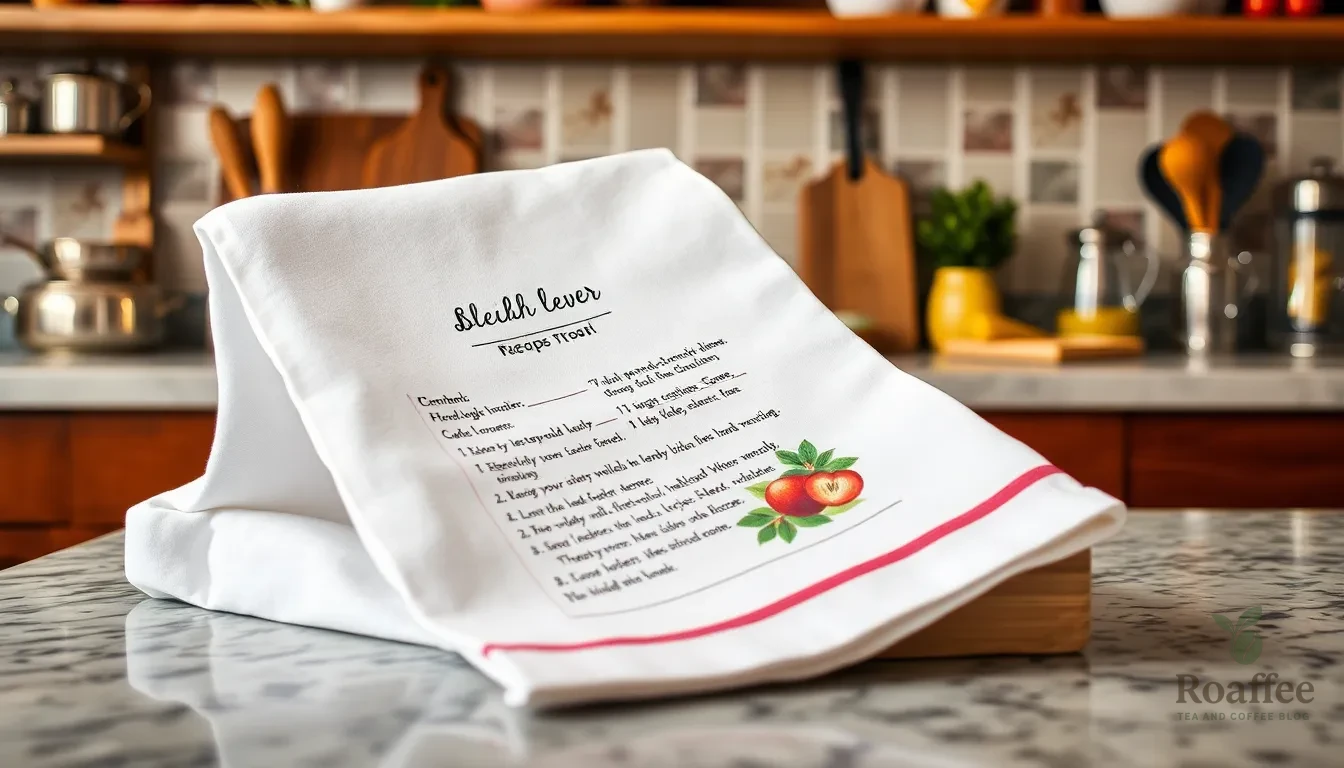
Follow these detailed steps to transform your chosen recipe into a beautiful and functional tea towel. Our systematic approach ensures professional results that will last through countless washes.
Prep Your Tea Towel
Start by pre-washing your tea towel in hot water without fabric softener to remove any sizing chemicals that might prevent ink absorption. We recommend washing the towel twice to ensure complete removal of manufacturing residues. Air dry the towel completely or use a low heat setting to prevent shrinkage.
Iron the tea towel on a flat surface using high heat to create a smooth working canvas. Place the towel on a hard surface covered with parchment paper to protect your work area. Mark the center point of the towel with a water-soluble fabric marker to guide your layout placement.
Choose Your Recipe Layout
Design your layout by determining the text size and positioning that best showcases your recipe. We suggest creating a border of 2-3 inches around all edges to frame your text attractively. Use a ruler to sketch light guidelines with a water-soluble marker for text alignment.
Consider organizing your recipe with the title at the top in larger text followed by ingredients and instructions in smaller fonts. Leave adequate white space between sections for visual clarity and readability. Test your layout on paper first to ensure proper spacing and proportions.
Transfer the Recipe Text
Apply your chosen transfer method carefully starting from the top of your design. For heat transfer vinyl we recommend using medium pressure for 15-20 seconds at 305°F. Remove the carrier sheet slowly while the vinyl is still warm to prevent lifting.
When using fabric markers write with steady consistent strokes and allow each line to dry completely before proceeding to the next. For transfer paper methods follow the manufacturer’s temperature and timing specifications exactly. Press firmly and evenly across the entire design to ensure proper adhesion.
Add Decorative Elements
Enhance your recipe tea towel with decorative borders frames or illustrations that complement your recipe theme. We suggest using stencils for consistent patterns or freehand drawing for personalized touches. Consider adding small icons representing key ingredients like wheat stalks for bread recipes or herbs for savory dishes.
Apply decorative elements after the main text has fully set to prevent smudging. Use coordinating colors that maintain readability while adding visual interest. Finish with a final heat setting if required by your chosen materials to ensure all elements remain permanent through washing.
Directions for Different Transfer Methods
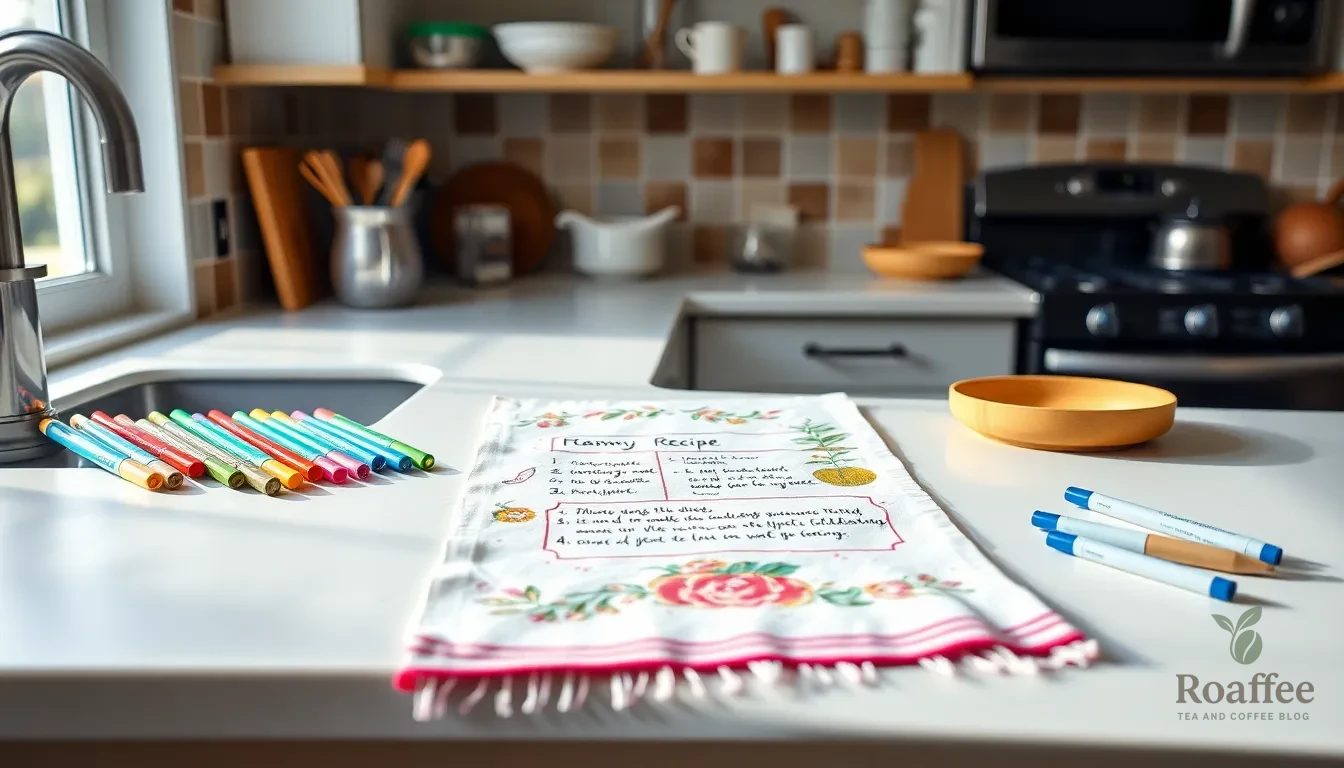
We’ll explore three proven methods to transfer your recipe onto tea towels, each offering distinct advantages for different skill levels and design preferences. Each technique produces durable, washable results that maintain recipe legibility through countless kitchen uses.
Hand-Lettering Method
We recommend gathering fabric markers, fabric paint pens, or permanent markers specifically designed for textiles before beginning this method. Position your tea towel on a flat surface and place a piece of cardboard inside to prevent ink bleeding through to the back. Sketch your recipe layout lightly with a pencil, marking where each section will appear on the towel.
Start lettering with the recipe title using your largest marker or pen, maintaining consistent pressure for even lines. Work systematically through the ingredients list, keeping spacing uniform between each item. Use a ruler or straight edge to ensure your text lines remain level across the towel.
Write the cooking instructions in a smaller font size, breaking longer steps into manageable chunks for better readability. Allow each section to dry completely before moving to the next to prevent smudging. We suggest practicing your lettering style on scrap fabric first to perfect your technique and ensure consistent results.
Iron-On Transfer Method
We start this method by printing your recipe design onto iron-on transfer paper using a standard inkjet printer. Cut the transfer paper close to your design edges, leaving about a quarter inch border for easier handling. Preheat your iron to the cotton setting without steam, ensuring the temperature reaches the manufacturer’s recommended heat level.
Place the transfer face down on your prepared tea towel, positioning it carefully since repositioning becomes difficult once heat is applied. Press the iron firmly over the entire transfer area for 15-20 seconds, applying steady pressure without sliding the iron. Work in sections if your design is large, overlapping iron placement slightly to ensure complete adhesion.
Remove the iron and immediately peel away the transfer backing while the material is still warm. We recommend working quickly during this step as the backing becomes more difficult to remove as it cools. Press the design again with a pressing cloth for 10-15 seconds to set the transfer permanently.
Fabric Paint Method
We begin by mixing fabric paint to achieve your desired color consistency, thinning with fabric medium if needed for smoother application. Secure your tea towel to a flat work surface using painter’s tape to prevent movement during painting. Load a fine-tip brush with paint, removing excess on a paper towel to prevent dripping.
Paint your recipe title first using steady, controlled strokes, maintaining consistent pressure for uniform lettering. Clean your brush between different sections to prevent color mixing and ensure crisp lines. We suggest working from top to bottom to avoid accidentally dragging your hand through wet paint.
Apply the ingredients and instructions using a smaller brush, taking care to maintain proper spacing between lines. Allow each section to dry for 10-15 minutes before proceeding to adjacent areas. Heat set the painted design according to the fabric paint manufacturer’s instructions, typically requiring 3-5 minutes of iron heat on the reverse side of the towel.
Make-Ahead Tips
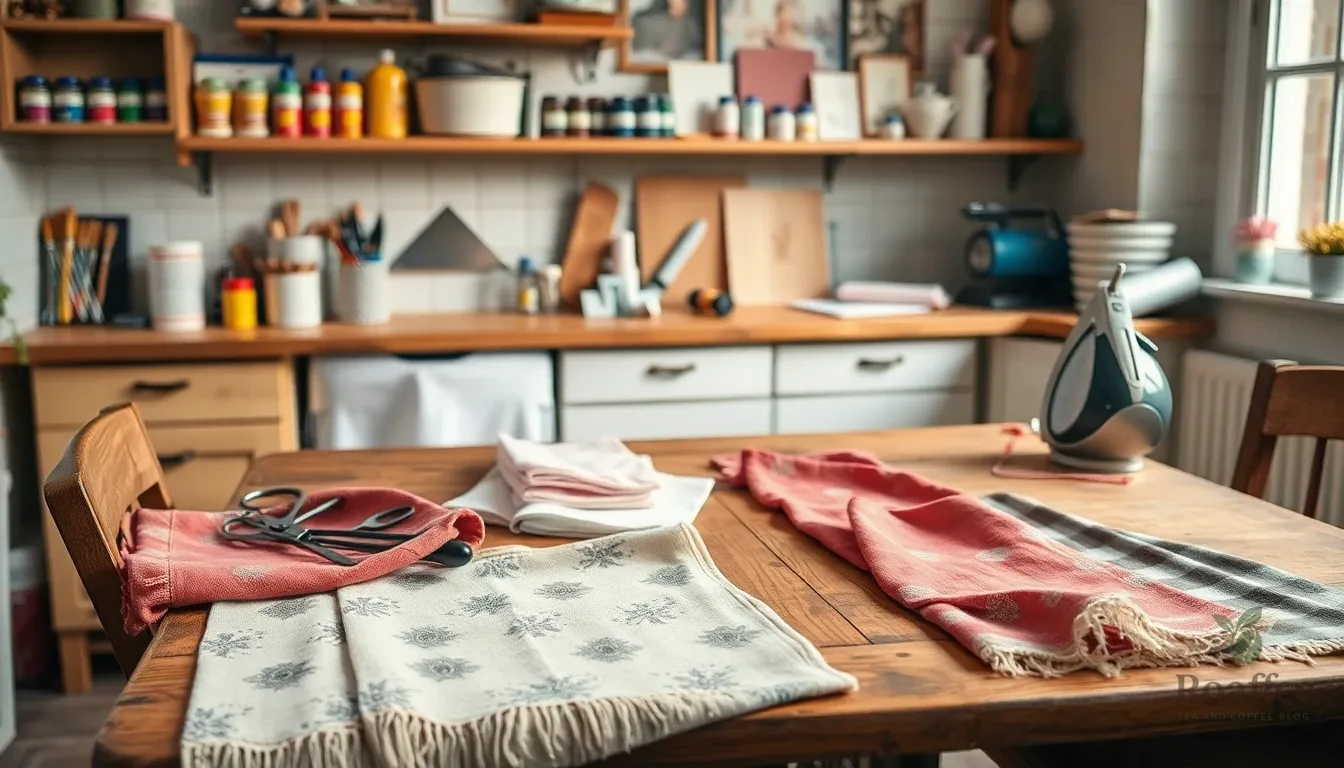
Planning ahead makes the recipe tea towel creation process smoother and more enjoyable. We recommend preparing your materials and workspace several days before you plan to start crafting. This approach allows you to gather all necessary supplies without rushing and ensures optimal results.
Preparation Timeline:
| Timeline | Task |
|---|---|
| 1 week before | Purchase tea towels and pre-wash them |
| 3-4 days before | Design and test your recipe layout |
| 2 days before | Print transfer materials or prepare stencils |
| 1 day before | Set up workspace and organize supplies |
Pre-washing your tea towels at least 24 hours in advance removes all sizing chemicals and allows the fabric to settle into its final dimensions. We store our washed towels flat in a clean drawer to prevent wrinkles and maintain their pristine condition. This step proves crucial because any remaining chemicals can interfere with ink adhesion or paint absorption.
Creating your design template ahead of time saves valuable crafting hours. We digitally format our recipes using word processing software and print test copies on regular paper first. This practice helps us identify spacing issues or font size problems before committing to the final transfer. Store your finalized design templates in protective sleeves to prevent damage from kitchen humidity or accidental spills.
Batch processing multiple towels becomes more efficient when you prepare transfer materials in advance. We cut all our transfer papers to size and organize them by recipe type. Iron-on transfers can be printed and stored flat for up to two weeks without losing their adhesive properties. Keep transfer papers in a cool dry place away from direct sunlight to maintain their quality.
Setting up your workspace the evening before eliminates morning delays and reduces stress during the actual crafting process. We arrange our iron on a stable surface with adequate ventilation and gather all fabric paints in one designated area. This organization prevents mid-project searches for essential tools and maintains your creative momentum.
Testing your chosen method on fabric scraps helps identify potential issues before working on your final tea towel. We always keep extra cotton fabric pieces for practice runs and technique refinement. This preliminary testing reveals how your exact paint brand behaves on your chosen towel material and helps perfect your application technique.
Care and Maintenance Instructions

Proper care ensures your recipe tea towels remain vibrant and functional for years to come. We recommend following exact washing guidelines to preserve the printed or painted recipe details while maintaining the towel’s absorbency.
Washing Guidelines
First wash your completed tea towels in cold water using mild detergent. Cold water prevents ink bleeding and preserves fabric integrity better than hot water. We suggest adding a cup of white vinegar to the first wash cycle to set the colors permanently.
Machine wash on a gentle cycle to minimize fabric stress and prevent text distortion. Avoid using bleach or fabric softeners as these chemicals can break down ink bonds and reduce fabric absorption. Separate your recipe tea towels from heavily soiled items during the first few washes to prevent potential staining.
Drying Methods
Air drying produces the best results for maintaining text clarity and fabric quality. Hang your tea towels on a clothesline or drying rack away from direct sunlight to prevent fading. Indoor drying works perfectly and eliminates weather dependency.
Low heat tumble drying offers a faster alternative when needed. Set your dryer to the lowest heat setting and remove towels while slightly damp to prevent over-drying. High heat can cause fabric shrinkage and may affect transferred designs.
Storage and Handling
Store your recipe tea towels in a clean dry drawer or linen closet between uses. Fold them carefully along natural creases to prevent permanent wrinkles that might distort recipe text. We recommend rotating between multiple towels to extend their lifespan.
Handle wet towels gently during cooking to prevent excessive stretching. Ring out excess water by pressing rather than twisting the fabric. This technique maintains the towel’s shape and prevents text areas from becoming distorted.
Long-term Maintenance
Iron your tea towels on medium heat when needed to restore crispness. Place a pressing cloth over printed areas to protect the design from direct heat exposure. Steam settings work well for removing wrinkles without direct iron contact.
Inspect your towels regularly for signs of wear or fading. Address minor issues promptly by touching up faded areas with matching fabric paint or markers. Replace towels when text becomes illegible or fabric develops holes that affect functionality.
Creative Design Ideas
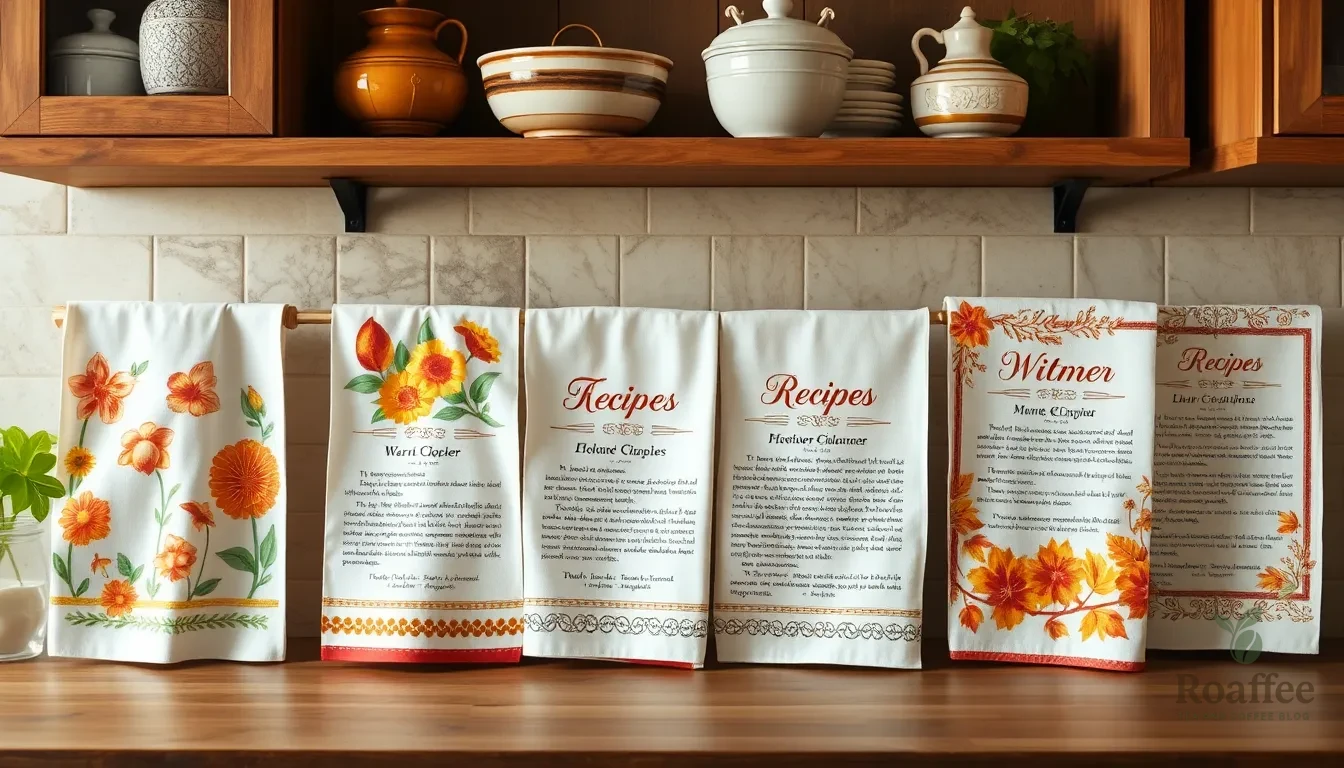
We can transform ordinary tea towels into extraordinary keepsakes with thoughtful design choices that celebrate culinary traditions. The right creative approach turns functional kitchen linens into meaningful conversation pieces.
Seasonal Recipe Themes
We love creating seasonal collections that capture the essence of each time of year through carefully chosen recipes. Spring tea towels feature fresh herb combinations and Easter bread recipes with delicate floral borders in soft pastels. Summer designs showcase berry preserves and grilling marinades with vibrant sunburst patterns and cheerful yellow accents.
Fall collections embrace warm spice blends and pumpkin recipes adorned with autumn leaves and harvest motifs in rich oranges and deep browns. Winter towels display holiday cookie recipes and warm beverage blends framed with snowflakes and evergreen branches in classic red and green palettes.
We recommend creating matching sets that tell the story of your family’s year through food. Each seasonal towel becomes a countdown to special occasions and treasured family gatherings.
Family Recipe Collections
We design family recipe collections that honor multiple generations of cooking wisdom on coordinated tea towels. Grandmother’s signature dishes deserve elegant script fonts paired with vintage-inspired borders and muted color schemes that reflect their timeless appeal.
Mother’s weeknight favorites work beautifully with modern typography and clean geometric patterns that represent efficiency and love. We often include personal touches like handwritten notes or small illustrations that reference family memories associated with each recipe.
Sibling recipe exchanges create wonderful matching sets where each towel represents a different family member’s specialty. We use consistent color schemes with varying accent colors to maintain unity while celebrating individual contributions to family traditions.
Recipe origin stories add meaningful context to each towel design. We incorporate small text blocks that explain when and why each recipe became special to your family.
Gift-Worthy Presentations
We create stunning gift presentations that elevate recipe tea towels from simple crafts to treasured heirlooms. Wedding gift sets feature the couple’s favorite recipes along with new ones to help them start their culinary journey together.
Bridal shower collections showcase recipes from different female relatives with each towel beautifully packaged in coordinating gift boxes. We include recipe cards that explain the significance of each dish and its place in family celebrations.
Housewarming gifts combine practical kitchen essentials with sentimental value by featuring recipes perfect for entertaining new neighbors. We pair these towels with coordinating kitchen accessories like wooden spoons or measuring cups.
Holiday gift sets celebrate exact occasions with themed recipe collections. Christmas towels feature cookie recipes and hot chocolate blends while Thanksgiving designs showcase stuffing variations and pie recipes that make every gathering special.
We recommend creating gift packaging that matches the towel designs using coordinating ribbons and recipe cards that explain the story behind each chosen recipe.
Troubleshooting Common Issues
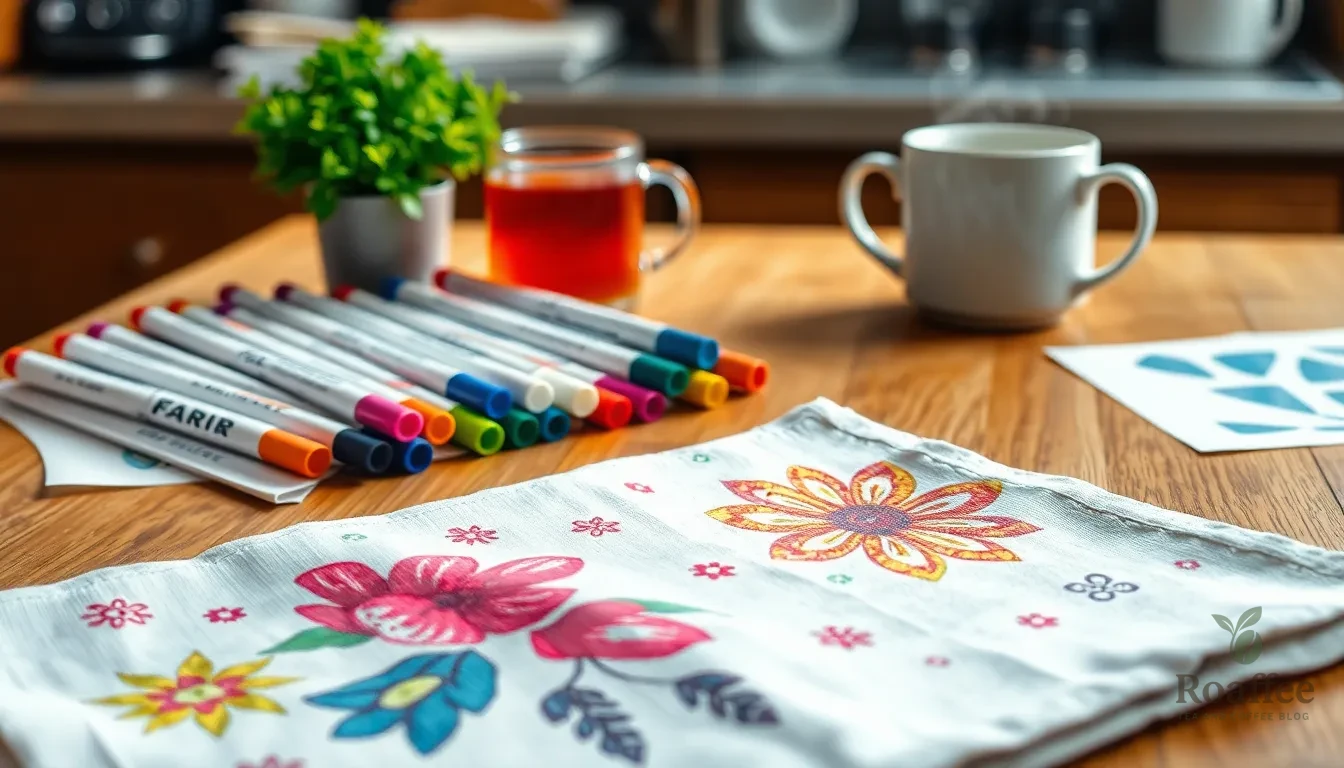
Creating recipe tea towels becomes more manageable when we address common problems before they occur. We encounter several challenges during the crafting process that can affect the final quality of our kitchen keepsakes.
Fabric Markers Bleeding or Fading
When fabric markers create blotchy or uneven lines, we need to check our towel preparation. Pre-washing removes sizing chemicals that prevent proper ink absorption. We recommend testing markers on a fabric scrap first to ensure compatibility. Bleeding often occurs when we press too hard or move too quickly with the marker. Light, steady pressure produces clean lines that remain vibrant after washing.
Transfer Paper Not Adhering Properly
Iron-on transfers require exact temperature and pressure settings to create permanent bonds. We ensure our iron reaches the correct temperature for the transfer paper type. Insufficient pressure or heat causes edges to lift after washing. We apply firm, even pressure for the full recommended time without sliding the iron. Allowing transfers to cool completely before peeling prevents premature lifting.
Fabric Paint Cracking or Peeling
Paint consistency affects durability and appearance on tea towels. We thin fabric paint slightly with water or fabric medium to improve flow and prevent cracking. Thick paint applications create rigid areas that crack when the towel flexes. We apply thin, even coats and allow each layer to dry completely before adding details. Heat setting with an iron after 24 hours ensures paint bonds permanently to fabric fibers.
Text Appearing Fuzzy or Unclear
Blurry text results from several factors we can control during creation. We select fonts that remain legible at smaller sizes and avoid overly decorative scripts for ingredient lists. Proper towel positioning prevents fabric movement during application. We secure corners with painter’s tape when using stencils or transfers. Smooth, wrinkle-free surfaces produce crisp text that maintains readability.
Colors Running During First Wash
Color bleeding damages the appearance of our carefully crafted recipe towels. We add one cup of white vinegar to the first wash cycle to set colors permanently. Cold water prevents dye migration between different colored elements. We wash new recipe towels separately from other laundry for the first few cycles. Testing colorfastness on a hidden area reveals potential bleeding issues before washing the entire towel.
Uneven Spacing or Crooked Lines
Layout problems affect the professional appearance of our recipe tea towels. We create guidelines using removable fabric pencils or lightweight rulers. Measuring distances between elements ensures consistent spacing throughout the design. We work from the center outward to maintain balance and alignment. Templates made from cardboard or paper help position repeated elements like bullet points or section headers.
Stencil Paint Bleeding Under Edges
Paint seepage creates messy borders that detract from clean design lines. We remove excess paint from brushes before applying color through stencils. Dabbing motions work better than brushing strokes for crisp edges. We secure stencils firmly against the fabric to prevent paint from seeping underneath. Removing stencils while paint remains slightly wet prevents pulling dried paint from the towel surface.
Storage and Display Options
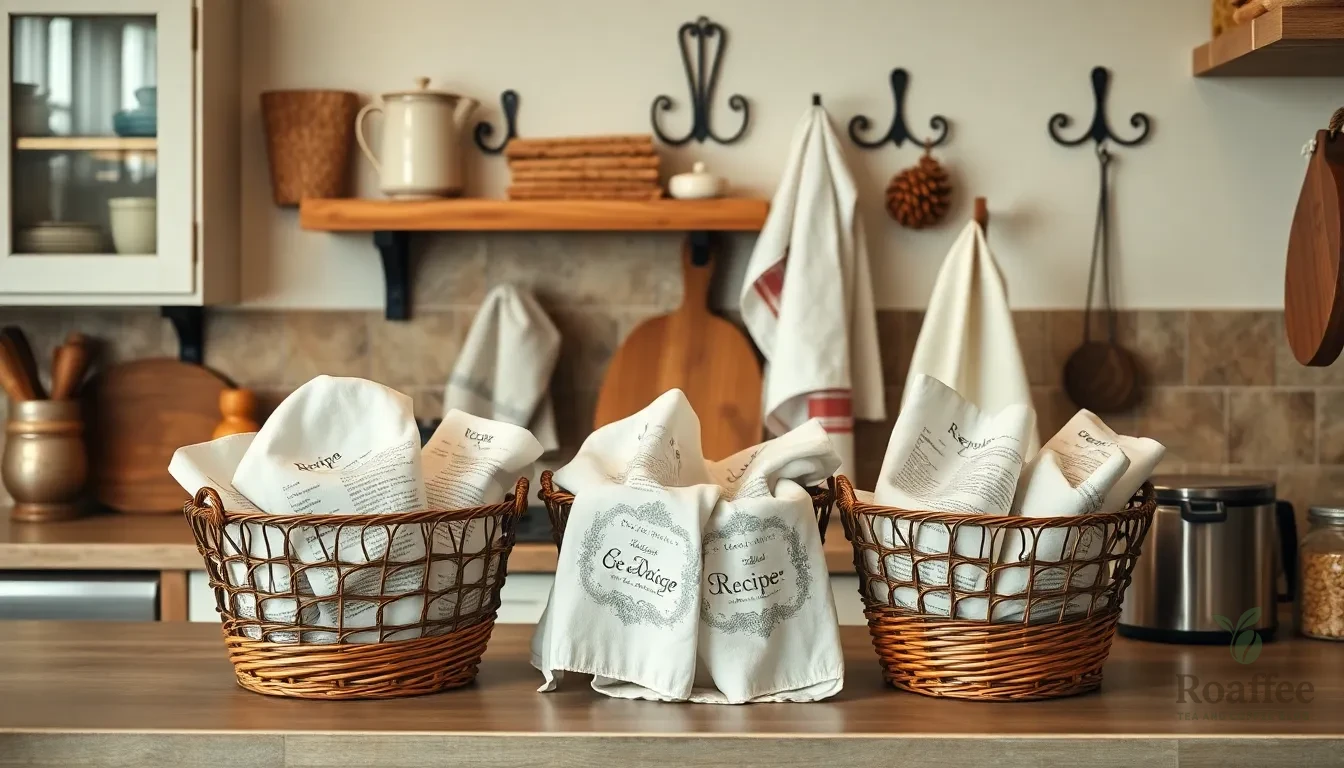
Recipe tea towels deserve thoughtful storage and display methods that preserve their quality while showcasing your culinary treasures. We recommend several practical approaches that protect your handcrafted keepsakes while making them accessible for daily use.
Proper Storage Techniques
Flat storage provides optimal protection for recipe tea towels with delicate text or embellishments. We suggest using acid-free tissue paper between folded towels to prevent ink transfer and maintain crisp lines. Large storage boxes or dresser drawers work perfectly for this method.
Rolling storage eliminates creases while protecting printed designs from pressure damage. We wrap each towel around a cardboard tube covered in muslin cloth to prevent direct contact with adhesives. This technique works especially well for towels with raised elements like embroidery or dimensional paint.
Cedar storage chests offer natural protection against moisture and pests while adding vintage charm to your storage solution. We place lavender sachets between towels to maintain freshness and deter insects naturally.
Display Answers for Daily Use
Kitchen hooks mounted on walls or inside cabinet doors keep recipe towels within easy reach during cooking. We position these hooks at eye level for comfortable reading while maintaining the towels’ decorative appeal.
Magnetic clips attached to refrigerators or metal surfaces provide instant access to frequently used recipes. We recommend using padded clips to prevent fabric damage and ensure secure attachment.
Decorative baskets on countertops or open shelving create organized storage that doubles as kitchen decor. We line baskets with coordinating fabric to prevent snagging and add visual cohesion to your kitchen design.
Rotating Display Systems
Seasonal rotation keeps recipe collections fresh and relevant throughout the year. We organize towels by cooking seasons and swap displays monthly to match current culinary activities.
Recipe stands or easels showcase individual towels as functional art pieces on countertops or dining tables. We select adjustable stands that accommodate different towel sizes and allow for easy viewing angles.
Shadow boxes create museum-quality displays for heirloom recipe towels too precious for daily use. We include small recipe cards or family photos to provide context and enhance the sentimental value of these displays.
Long-Term Preservation Methods
Climate-controlled storage protects valuable recipe towels from temperature fluctuations and humidity damage. We maintain consistent conditions between 65-70°F with 45-55% humidity for optimal fabric preservation.
Archival storage materials including acid-free boxes and tissue paper prevent chemical deterioration over time. We document each towel with creation dates and care instructions to maintain historical records.
Digital documentation through high-resolution photography preserves recipe content even if physical towels deteriorate. We create backup files stored in multiple locations to ensure permanent access to cherished family recipes.
Conclusion
Recipe tea towels represent the perfect marriage of functionality and sentiment in our kitchens. We’ve explored every aspect of creating these treasured keepsakes—from selecting the right materials to mastering transfer techniques that ensure lasting quality.
These personalized kitchen textiles offer us a unique way to honor family traditions while solving everyday cooking challenges. They keep our beloved recipes visible and accessible without the worry of damaging fragile handwritten cards or messy phone screens.
Whether we’re crafting them as heartfelt gifts or preserving our own family’s culinary heritage we’re creating something truly special. With proper care and creative presentation these recipe tea towels will serve as functional reminders of the love and tradition that make our kitchens the heart of our homes.
Frequently Asked Questions
What is a recipe tea towel?
A recipe tea towel is a functional kitchen linen featuring a family recipe printed or painted directly onto the fabric. These custom textiles serve as both practical cooking tools and sentimental keepsakes, allowing you to reference recipes while cooking without handling delicate recipe cards or phone screens with messy hands.
What materials do I need to make a recipe tea towel?
You’ll need 100% cotton tea towels, your chosen transfer method (fabric markers, iron-on transfer paper, or fabric paint), and basic crafting supplies. Pre-wash the towels to remove sizing chemicals and iron them smooth before starting. Having your recipe formatted and ready will streamline the process.
Which transfer method works best for beginners?
Iron-on transfer paper is ideal for beginners as it requires minimal artistic skill and produces professional-looking results. Simply print your recipe design onto transfer paper and apply it with an iron. This method ensures clear, readable text that withstands multiple washes when applied correctly.
How do I care for my finished recipe tea towels?
Wash in cold water with mild detergent on a gentle cycle. Add white vinegar to the first wash to set colors. Air dry or use low heat tumble drying to maintain text clarity. When ironing, use a pressing cloth to protect the design and preserve the recipe’s readability.
Can I make multiple tea towels from one recipe?
Yes, creating multiple tea towels from a single design is cost-effective and efficient. Batch processing allows you to make several keepsakes at once for gifts or family members. This approach also helps preserve fragile handwritten recipes in a durable, washable format that multiple people can enjoy.
What makes recipe tea towels good gifts?
Recipe tea towels combine practicality with deep sentimental value, making them perfect for weddings, housewarmings, and holidays. They celebrate family traditions while being actively used in the kitchen, creating moments of connection with family history. Their durability ensures the recipes will be preserved for future generations.
How should I store my recipe tea towels?
Store flat with acid-free tissue paper to prevent ink transfer, or roll around cardboard tubes to eliminate creases. Cedar chests provide natural protection for long-term storage. For daily use, hang on kitchen hooks or magnetic clips to keep them accessible while maintaining organization.
What if my fabric markers bleed or paint cracks?
Fabric marker bleeding usually results from using low-quality markers or not allowing proper drying time. Use high-quality fabric markers and let each section dry completely. Paint cracking occurs when applied too thickly or dried too quickly. Apply thin, even coats and allow natural air drying between applications.

